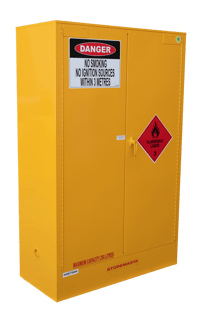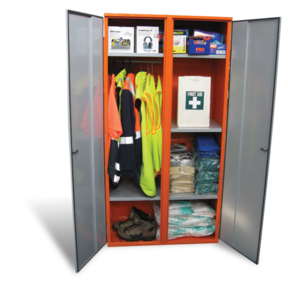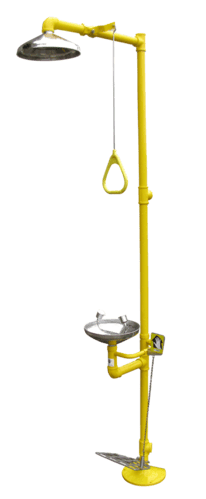Read this blog if you are about to setup a new flammable liquids store, or want to assess your existing setup for efficiency and compliance. Flammable liquids are not only hazardous to human health, but they can cause catastrophic fires, explosions and environmental damage. Don’t leave chemical storage to an off-the-shelf purchase without a risk assessment and thorough compliance check.
1. Cabinets

Flammable liquids cabinets that have been manufactured to Australian Safety Standards are the ideal storage solution for smaller quantities of flammable and combustible liquids. Flammable liquids left out in the open are vulnerable to heat, sparks, static electricity — and it’s so easy for flammable chemicals to accumulate around a job site when there is no clear storage area for paint tins, solvents, glue, resin, petrol jerrycans and cleaning chemicals.
Inside a safety cabinet your chemicals are protected by double-walled sheet steel, self-closing doors, and construction componentry that can withstand temperatures of more than 850 degrees Celsius. Each cabinet also acts as a liquid tight enclosure — keeping leaks, spills, vapours and fumes fully contained.
Flammable liquids cabinets come in sizes ranging from 30 litres to 850 litres: allowing you to store everything from small quantities of paint, cleaning chemicals or petrol — to 205 litre oil and fuel drums. Choose smaller (horizontally shaped) cabinets for under-bench storage, tall slim designs for tight spaces, or heavy-duty cabinets with construction materials 25% stronger than standard.
2. Location
Australian Safety Standards have strict requirements for where a flammable liquids cabinet can (and cannot be placed). In brief:
- Indoor flammable liquids cabinets must not be placed within 3 metres of an ignition source (industrial heat, electrical sockets, hot work).
- Cabinets must not block emergency exits or interfere with the natural flow of people evacuating a building.
- Large capacity cabinets (more than 250 litres) cannot be installed against a common wall or in a public building (hospital, school, aged care facility, hotel etc).
- Aggregate quantities of flammable liquids stored indoors are capped at 850 litres (ground floor) per 250 square metres, and 250 litres (higher levels) per 250 square metres. Each aggregate quantity must be kept at least 10 metres apart.
3. Decanting
Chemical drums and containers stored inside a flammable liquid’s cabinet must have their caps and seals in place — or have a tap installed. This is a requirement of Australian Safety Standards and an important consideration if you intend decanting chemicals from your cabinet.
Flammable liquids cabinets have self-closing doors and are specifically designed to be kept closed at all times — if you want to decant from the cabinet always carry out a risk assessment to ensure you aren’t creating additional hazards. Considerations include:
- Fire and explosion hazards — is the cabinet in the proximity of ignition sources (heat, flames, machinery, electrical discharge)?
- Vapours and fumes — will decanting push concentration levels of vapours and fumes above workplace exposure standards?
- Chemical spills — decanting increases the risk of chemical spillage, what additional spill protection do you have in place?
- Compatibility hazards — is the cabinet at least 3-5 metres from different chemical hazard classes (eg, toxic and corrosives chemicals, oxidisers, organic peroxides)?
REMEMBER: It is often more efficient to setup a standalone decanting station away from the indoor store. Check out STOREMASTA’s fully enclosed lube and decanting stations.
4. Personal Protective Equipment (PPE)
 Personal Protective Equipment (PPE) refers to the protective clothing and equipment (eg, masks, gloves, goggles) that create a barrier between a worker and flammable liquids. But PPE cannot protect a worker if they aren’t wearing it.
Personal Protective Equipment (PPE) refers to the protective clothing and equipment (eg, masks, gloves, goggles) that create a barrier between a worker and flammable liquids. But PPE cannot protect a worker if they aren’t wearing it.
Your indoor flammable liquids store should also incorporate the location and storage of essential PPE — ensuring it is both accessible and protected from theft or damage. We make the following recommendations:
- Don’t store PPE inside the flammable liquid’s cabinet — it could be contaminated by fumes and liquid spills.
- Keep PPE in a stainless-steel cabinet purpose-built for PPE storage — these cabinets secure your expensive PPE and protect it from mice, rats, cockroaches, ants, water and dust). PPE cabinets also arrive with pre-installed safety signage.
- Don’t store PPE too far away from the chemicals.
5. First Aid and Decontamination
 Flammable and combustible liquids can cause serious injuries if they are accidentally ingested, inhaled or splash onto the skin or eyes of workers. Your risk assessment should determine the type of injuries that are possible, but you will need (as a minimum):
Flammable and combustible liquids can cause serious injuries if they are accidentally ingested, inhaled or splash onto the skin or eyes of workers. Your risk assessment should determine the type of injuries that are possible, but you will need (as a minimum):
- Register of Hazardous Chemicals — use a purpose-built Document Box and attach to the side of your Flammable Liquids cabinet.
- First aid station — you must have suitable first aid equipment immediately accessible to the chemical hazards.
- Safety Shower — if workers are at risk of skin damage or burns install a plumbed safety shower within a 10 second reach of the cabinet.
- Emergency Eye wash — for low risk and smaller quantities of chemicals, you can include hand bottles of eyewash in your first aid kit. For larger quantities or extremely hazardous chemicals install a plumbed eyewash unit within 2-5 metres of your cabinet.
Next steps
Don’t setup your indoor flammable liquids storage area without reading our free eBook Essential Considerations When Storing Flammable Liquids Indoors. It contains all the information you need to carry out a risk assessment on your existing chemical stores, then select and install a safety cabinet that complies with Australian Safety Standards. Download and read it today by clicking on the image below:
Joining the team as a Dangerous Goods Storage Consultant, Melissa Hampton became Storemasta's Marketing Manager in late 2021. With extensive knowledge and experience in chemical compliance, Melissa is responsible for leading the Marketing team and helping shape their marketing strategy. In her spare time, you can find Melissa hiking, swimming and enjoying the great outdoors in beautiful north-west Tasmania.
